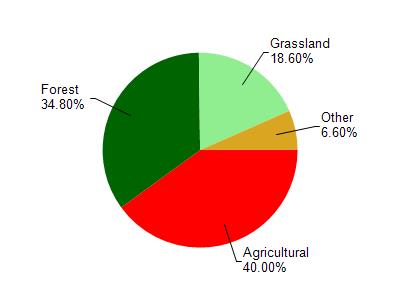Dunn
Yes
No
No
Fish and Aquatic Life
Overview
The Ridgeland wastewater treatment plant moved its discharge from South Fork Lower Pine
Creek to Lower Pine Creek in 1978. A post-operative point source study was conducted and
concluded that even after the old discharge was eliminated, the South Fork Lower Pine Creek still
did not meet water quality standards for dissolved oxygen. The macroinvertebrate data suggests that
polluted runoff may be the controlling factor. The new discharge had no adverse effect on Lower
Pine Creek during the study period (LaLiberte). Lower Pine Creek begins in Barron County where
streambank pasturing has degraded habitat. Barnyard runoff has been a problem in the past in some
locations (WDNR n.d.3.
Date 1996
Author Aquatic Biologist
Condition
Wisconsin has over 84,000 miles of streams, 15,000 lakes and milllions of acres of wetlands. Assessing the condition of this vast amount of water is challenging. The state's water monitoring program uses a media-based, cross-program approach to analyze water condition. An updated monitoring strategy (2015-2020) is now available. Compliance with Clean Water Act fishable, swimmable standards are located in the Executive Summary of Water Condition in 2018. See also the 'monitoring and projects' tab.
Reports
Management Goals
Wisconsin's Water Quality Standards provide qualitative and quantitative goals for waters that are protective of Fishable, Swimmable conditions [Learn more]. Waters that do not meet water quality standards are considered impaired and restoration actions are planned and carried out until the water is once again fishable and swimmable
Management goals can include creation or implementation of a Total Maximum Daily Load analysis, a Nine Key Element Plan, or other restoration work, education and outreach and more. If specific recommendations exist for this water, they will be displayed below online.
Monitoring
Monitoring the condition of a river, stream, or lake includes gathering physical, chemical, biological, and habitat data. Comprehensive studies often gather all these parameters in great detail, while lighter assessment events will involve sampling physical, chemical and biological data such as macroinvertebrates. Aquatic macroinvertebrates and fish communities integrate watershed or catchment condition, providing great insight into overall ecosystem health. Chemical and habitat parameters tell researchers more about human induced problems including contaminated runoff, point source dischargers, or habitat issues that foster or limit the potential of aquatic communities to thrive in a given area. Wisconsin's Water Monitoring Strategy was recenty updated.
Grants and Management Projects
Monitoring Projects
| WBIC | Official Waterbody Name | Station ID | Station Name | Earliest Fieldwork Date | Latest Fieldwork Date | View Station | View Data |
|---|
| 2085600 | South Fork Lower Pine Creek | 10008753 | 3 S. Fork Lower Pine Cr Cth V | | | Map | Data |
| 2085600 | South Fork Lower Pine Creek | 10008758 | 4 S. Fork Lower Pine Cr Sth 25 | | | Map | Data |
| 2085600 | South Fork Lower Pine Creek | 173211 | Ridgeland Stp Outfall | | | Map | Data |
| 2085600 | South Fork Lower Pine Creek | 10044316 | South Fork Lower Pine Creek - bridge in NW NE S6 | | | Map | Data |
| 2085600 | South Fork Lower Pine Creek | 10008750 | South Fork Lower Pine Cr at Cty AA/V | | | Map | Data |
|

Watershed Characteristics
South Fork Lower Pine Creek is located in the Pine Creek and Red Cedar River watershed which is 287.89 mi². Land use in the watershed is primarily agricultural (40%), forest (34.80%) and a mix of grassland (18.60%) and other uses (6.60%). This watershed has 538.68 stream miles, 84.94 lake acres and 12,197.18 wetland acres.
Nonpoint Source Characteristics
This watershed is ranked High for runoff impacts on streams, Low for runoff impacts on lakes and High for runoff impacts on groundwater and therefore has an overall rank of High. This value can be used in ranking the watershed or individual waterbodies for grant funding under state and county programs.However, all waters are affected by diffuse pollutant sources regardless of initial water quality. Applications for specific runoff projects under state or county grant programs may be pursued. For more information, go to surface water program grants.